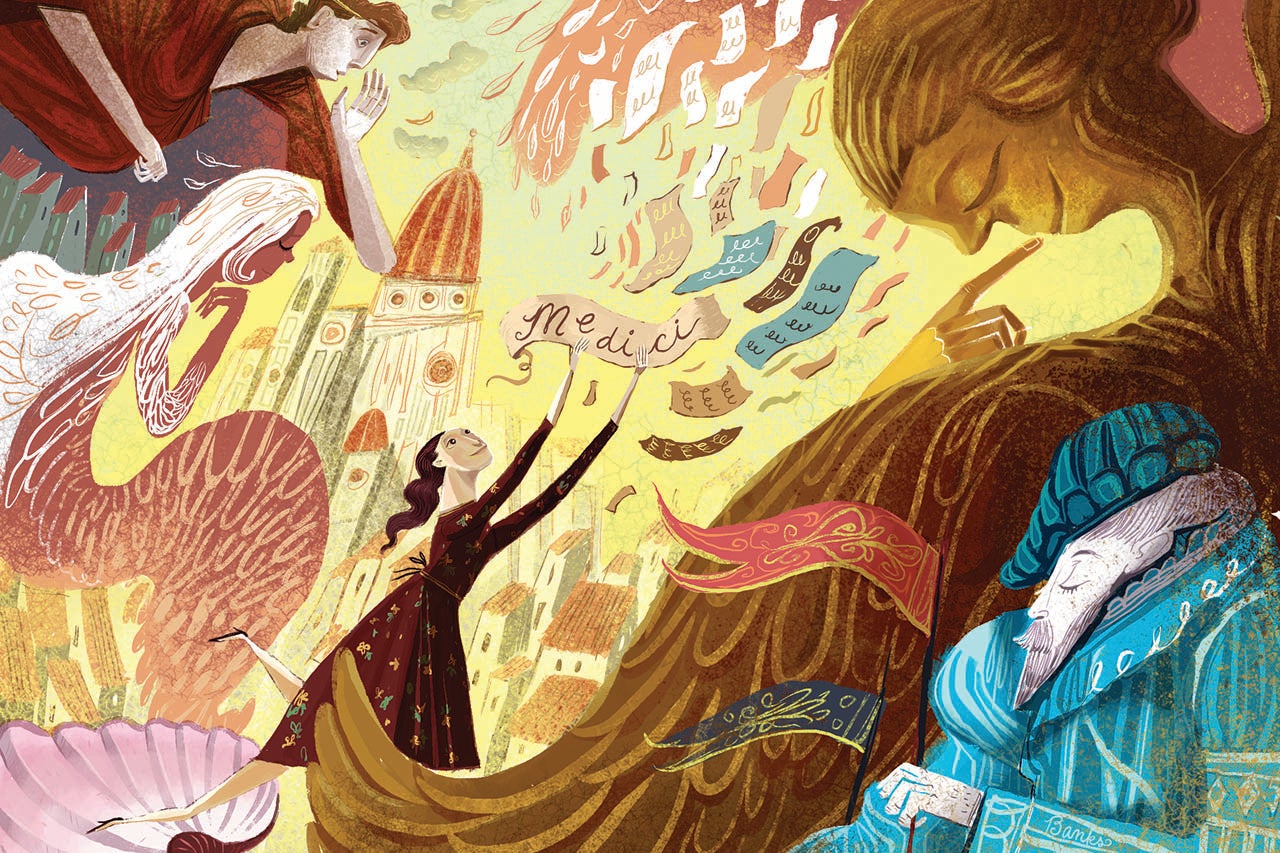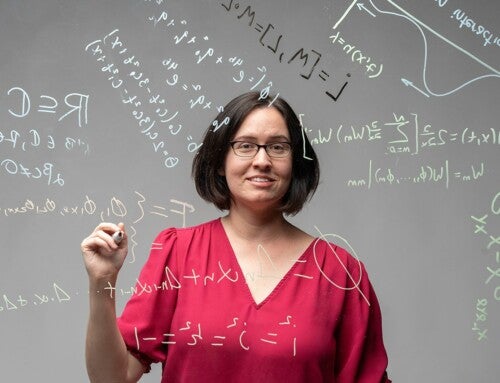Over the course of six days and lots of espresso in Florence, Italy, this art history professor studied the massive archives of the famed Medici family, learning firsthand about Renaissance celebrities such as Michelangelo and Catherine de’ Medici.
By Rebekah Compton
I departed from Charleston to attend the Medici Archive Project (MAP) Seminar on January 3, 2019, at a transitional life moment: one of loss but also one of new beginnings. The goal of my sojourn was to read Renaissance archival documents. For the first time in more than a decade, I was also traveling to Florence and not studying Venus. A few days before the trip, I completed my book manuscript, Venus and the Arts of Love in Renaissance Florence, a project that began as my dissertation at the University of California, Berkeley; took shape during a Mellon Postdoctoral Fellowship at Columbia University; and crystallized into a book at the College of Charleston. I was starting a new project and climbing the proverbial Neoplatonic ladder from terrestrial to celestial love. It was strange to visit the Uffizi Galleries and not study Botticelli’s Primavera or Birth of Venus. Instead of goddesses, I looked at angels: bright, winged creatures with innocent faces and shimmering attire, lovely red seraphim and wise blue cherubim alighting on glittering gold grounds.
After a few days of viewing art, I moved into my home for the week, a room in the Robert F. Kennedy International House for Human Rights. In the 15th century, this building housed cloistered Benedictine nuns and was fondly called “Le Murate,” meaning “walled up.” Catherine de’ Medici, who would become the queen of France, had been hidden inside this convent for three years after German soldiers sacked Rome in 1527. The door to my room stood beside one of the original wooden doors of the convent. I imagined a tiny 8-year-old Catherine, whose parents died shortly after her birth, huddling inside these walls in the January cold. I was freezing, too!
On Monday, the MAP Seminar began. Our first session was led by Alessio Assonitis, who has directed the project since 2004 and worked tirelessly to support the study, conservation and digitization of the Medici family’s documents. Our class consisted of 10 students from Europe and America. We were all there to learn the basics of archival research – an endeavor, we soon realized, that was not only challenging, but also time consuming. The Florentine State Archive, for example, houses “70 kilometers” (43.4 miles) of documents. One section of the Medici Archives alone, as Assonitis pointed out, takes up one mile of shelf space. This massive collection has luckily survived the tests of time, including the 1966 flood and the city’s wartime occupation between 1943 and 1944. Other cities, such as Naples, were not so fortunate. On September 30, 1943, Nazi soldiers burned the Naples State Archives to the ground and destroyed hundreds of years of history. Thankfully, the city of Florence has been able to save its history with the conservation of millions and millions of documents: birth records, death records, inventories, contracts, wills, marriage certificates, property disputes, legal affidavits, membership rosters, account books, memoirs, poems, treatises, petitions, diplomatic correspondence, papal bulls and even passports. Where were we to begin?
Well … first, we had to learn how to read! Our initial exercise was a translation of a record of payment written by Michelangelo Buonarroti to Pope Leo X, Giovanni di Lorenzo de’ Medici (1475–1521). It was extremely difficult to distinguish between the handwritten letters. Was that an r or a t, an e or a c, an m or an n? Suddenly, I understood what preschool must be like for my 3-year-old. I actually had to learn the alphabet again! Then, there were the abbreviations, a wide variety of curving and slashing marks, above and below letters, which signified whole words. Who knew that you could write September as 7br? Slowly, we read, “I Michelangelo have received today this of the 25 of February from Pope Leo X …” Having studied Italian for years, I yelled out words that I seemed to recognize; however, many of my guesses were incorrect! I thought of my first-grader and his eager excitement after “getting a word right” in his journey of learning how to read.
Over the course of the week, we examined letters, poems and notes written by or about Renaissance celebrities: Donatello, Leonardo da Vinci, Marsilio Ficino, Lorenzo the Magnificent, Lucrezia Borgia, Duke Cosimo I and Artemisia Gentileschi. Because Florence was a mercantile society, records were of the utmost importance, particularly those that tracked the comings and goings of money. During the 1400s, Florentines wrote with oak gall ink, in a mercantile script, on rag-pulp paper or goat skin parchment. This 15th-century script is much more difficult to read than that of the 16th century. After the development of the printing press by Gutenberg in 1440, handwriting in Europe became more standardized.
Our seminar met daily from 9 a.m. to 7 p.m. with four two-hour sessions and a two-hour lunch break. Marcello Simonetta, a senior researcher for MAP and a mastermind of the archives, directed two of our sessions. He introduced us to the scandalous world of diplomatic correspondence, where one can read about murder, sex, conspiracy and massacre but also about art, marriages, conversions and miracles. Simonetta is a specialist in ciphers and taught us how to decode an encrypted letter to Giulio de’ Medici (1478–1534), who became Pope Clement VII in 1523. A cipher might be constructed, for example, with the following three rules: 1. normal letters, with no marks, refer to the previous letter in the alphabet; 2. letters with a superscript indicate a vowel, and the superscript designates the vowel (1-a, 2-e, 3-i, 4-o, 5-u); and 3. underlined letters are decoys to be ignored. The following word, for example, would be cipher for college: dv4mtmy2hf2.
Over the course of six days and lots of espresso, we learned a lifetime of information. Sheila Barker, for example, taught us how to find documents related to art: contracts, inventories, materials, loans, restorations and even delivery tips. Pasquale Focarile explained the challenges of trying to view private archives, which have remained in the hands of certain families for more than 500 years. We learned about Florence’s legal system and how to find court records. We learned about the circulation of handwritten news ordered by subscription. (Immediately, it was clear that the news has never been truthful!) On the next-to-last day, we traveled to the Venetian State Archives, which, since 1815, have been kept in the former convent of the Basilica Maria Gloriosa dei Frari. There, we learned the paleographic alphabet and its evolution since Roman inscriptions. We wandered through ice-cold rooms housing shelf upon shelf of folios, marked with illegible numbers and letters. No wonder one must wait several hours or a full day after putting in a request to view a file!
I am grateful to the College of Charleston and the Department of Art and Architectural History for funding my trip to Italy for the MAP Seminar. Armed with a whole new set of skills, I anticipate returning to Florence and leafing through the stacks of brittled and browned paper collected in vellum binders, neatly tied with brown shoestring ribbons, by the last scholar who opened the file. I look forward to the challenge of flipping through sheet after sheet in search of a particular name or date, to the intuitive inkling that something important is about to be found (at least in the next hour) and to the inspired hope that my reading of the material is correct. Is that date 1553 or 1583? And this is where MAP is most beneficial: It provides an ensemble of archivists who have the answers, a network of friends to share findings with and to support one another in the solitary task of reading in this vast “ocean of papers.”
– Rebekah Compton is an assistant professor of Renaissance and Baroque art
in the Department of Art and Architectural History who specializes in
painting, sculpture and architecture created within Italy between 1400 and 1600.
Featured illustration by Timothy Banks.




